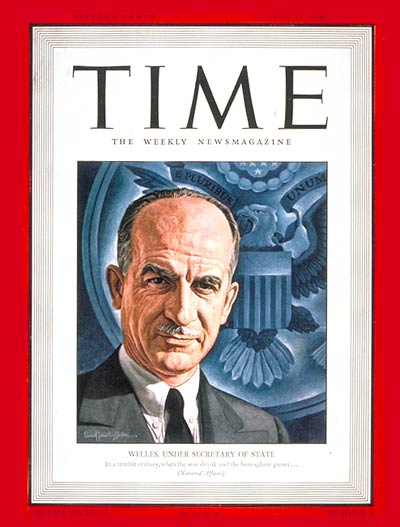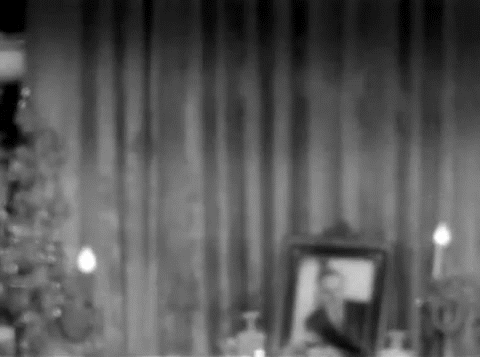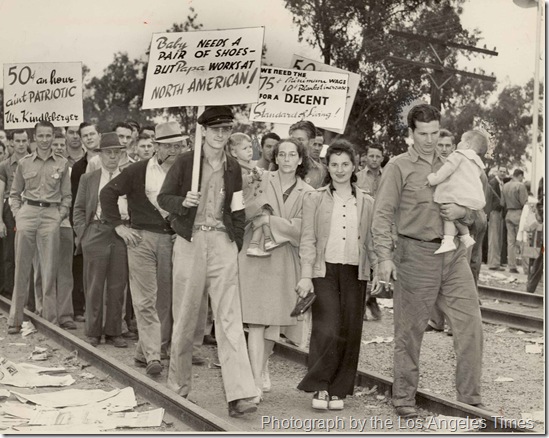Thursday 14 August 1941
 |
| A Finnish soldier collecting potatoes for tonight's dinner, 14 August 1941 (SA-Kuva). |
Eastern Front: OKH Chief of Staff Franz Halder notes in the war diary on 14 August 1941 that Finnish achievements so far in the war are "truly remarkable." Morale is good in the army, but he notes that "Losses in the armored and rifle units considerable." Due to tank losses, the armored divisions have "an abundance of personnel," while the rifle divisions are short of men. Field Marshal von Bock, commander of Army Group Center, complains that Reichsmarschall Hermann Goering is shifting air support without consulting him, and a fierce debate rages whether Yelnya is worth keeping due to the heavy losses there.
Reports in other army commands are a little more direct about the actual situation than Halder. Generalleutnant Hans Reichsfreiherr von Boineburg-Lengsfeld, commander of the 4th Panzer Division which is with XXIV Panzer Corps, notes in his war diary that
In the Far North sector, the Finnish 18th Division of II Corps captures the key town of Antrea (Kamennogorsk) in the center of the Karelian Isthmus on the left bank of the Vuoksa River. The Finns now are 170 km (110 miles) northwest of Leningrad. Antrea is important strategically because it controls one of the few bridges across the river, and taking it traps Soviet 115th Rifle Division on the wrong side of the river. The Soviet division now must either succumb or find a way to cross the forests and river to rejoin Soviet 19th Corps near Vyborg (Viipuri), the prime target in the sector.
Going is slow in this region due to the harsh terrain with few roads, which slows down even the Finns who are experts at going across the roughest country. Already, some Soviet units such as 142nd Rifle and 198s Motorized Divisions are backed against Lake Ladoga with no way out except by boat. Finnish I Corps also is making good progress to the east, with 2nd, 7th, and 19th divisions on the verge of taking Sortavala, where the Soviets also have no landward line of retreat.
A little further north, Finnish Group J of III Corps today confirms that the Soviets have brought in the 88th Rifle Division from Archangel (Arkhangelsk) to the north in order to block their advance to Loukhi. Thus, the Finnish advance to the Murmansk railway, a key strategic objective only 20 miles away along a spur railway line and improved road, is stopped for the time being.
In the Army Group North sector, the Germans make some forward progress at Luga and on either end of Lake Ilmen. The Soviets pierce the German line south of Lake Ilmen with a cavalry division, a reminder that the German line is being stretched thin with little behind the hard crust at the front.
In the Army Group Center sector, General Halder notes in the war diary that there are "gratifying successes against the enemy in the Rogachev salient" but that "costly fighting continues" at Yelnya. "All quiet elsewhere on the front." Panzer Group 2 approaches Bryansk, where the Soviets are concentrating in order to protect Kyiv from exactly what the Germans have in mind - an attack south toward Kyiv.
In the Army Group South sector, the German capture of Cherson on the Dneiper makes the Soviet position at Nikolayev (Nikolaev) untenable. Thus, after dark today the Soviets begin evacuating the port, and in the process destroy the unfinished 59,150-ton battleship Sovetskaya Ukraina and several other ships under construction, including:
The Germans advance to within sight of Krivoy Rog (Kryvi Rih) due north of the neck of the Crimea. It is a regional center of iron-ore mining, one of the economic objectives that Hitler prefers over political objectives such as Moscow.
Luftwaffe Oblt. Heinz Bär of JG 51 receives the Eichenlaub for achieving 60 kills, while Hptm. Hans ‘Assi’ Hahn of JG 2 also receives it for 42 victories. In the air, Lt. Max-Hellmuth Ostermann of 7./JG 54 claims two Soviet I-153s over the Bay of Kolga. German pilots are racking up huge sums of victories on the Eastern Front, much quicker than has happened on the Western Front.
European Air Operations: During the day, the RAF sends 26 Blenheim bombers on coastal sweeps all along the continental coastline. The bombers attack shipping and dockyards in Boulogne harbor and further north. The British lose one airplane. There is another raid by five Blenheim bombers to the Marquise ammunition factory, but they turn back without attacking.
After dark, RAF Bomber Command mounts another large effort against three German targets: Hanover (Hannover), Brunswick, and Magdeburg.
Against Hanover, the British send 152 bombers (96 Wellingtons, 55 Whitleys, and 1 Stirling. The British lose 5 Wellingtons and four Whitleys during attacks that use the main railway stations as targets.
Against Brunswick, the British send 81 Hampdens also to bomb railway targets. One aircraft fails to return.
Against Magdeburg, the British send 52 bombers (27 Wellingtons, 9 Halifaxes, 9 Stirlings, and 7 Manchester bombers). Once again, the targets are railway stations. There is cloud cover over the target that forces the bombers to drop their loads by guesswork. The British lose two Wellingtons, one Halifax, and one Stirling.
The RAF sends minor diversionary raids to Boulogne (13 Wellingtons), Rotterdam (9 Wellingtons and Whitleys), Dunkirk (two Wellingtons), and on minelaying in the Frisian Islands. All of these bombers return.
Overall, it is not a bad night for the RAF. For 314 sorties, the British only lose 14 bombers for a 4.5% loss rate. In terms of maintaining a sustainable bombing campaign, this is considered acceptable, as the average crewman can be expected to survive a 20-mission tour. Naturally, the lower, the better, 14 bombers is still a lot to lose and a lot of RAF crewmen wind up in POW camps after a night like this.
The Luftwaffe sends a few bombers against the north of England. The German planes drop their bombs at random, in fields and along roads, then head home quickly. Targets hit include the vicinities of Northumberland, Gateshead (4 killed), and Bishop Auckland. The damage is minimal, but occasional "lucky hits" destroy a road here or there, cut some utility lines, or land on luckless people in their homes.
Luftwaffe Oberstleutnant Wolfgang Schenck earns the Knight's Cross Oberleutnant and Staffelkapitän of the 1./SKG 210.
Battle of the Baltic: The Luftwaffe bombs and sinks Soviet transport Sibir, which is carrying 2500 wounded from Tallinn, Estonia to Kronstadt near Leningrad. An estimated 400+ perish. The date of this sinking is disputed, some sources place it on 19 August.
Two ships hit mines laid by German S-boats:
Battle of the Atlantic: Italian submarine Guglielmo Marconi spots independent 2589-ton Yugoslavian freighter Sud hundreds of miles west of Portugal. Marconi fires a torpedo and misses, then surfaces and uses its deck gun, severely damaging but not sinking Sud. U-126 (Kptlt. Ernst Bauer), on its first patrol out of Kiel, also is in the vicinity and torpedoes and finishes off Sud four hours later. The entire 33-man crew survives and picked up by Portuguese freighter Alferrarede. Sud was traveling as part of Convoy HG-70 but fell behind. This is the fifth success of the patrol for Bauer and U-126, with sinkings totaling 13,693 tons.
RAF Coastal Command planes bombs and sinks 1193-ton German freighter Lotte Halm off Borkum.
Royal Navy armed merchant cruiser HMS Circassia captures 4272-ton Italian freighter Stella west of the Cape Verde Islands. The British put aboard a prize crew and send it to Bermuda. Stella is later renamed Empire Planet and put into service.
US 2686-ton freighter Norlindo (some sources say Norluna) collides with US Navy submarine chaser PC-457 off San Juan, Puerto Rico. As is usually the case, the bigger ship wins, and PC-457 goes to the bottom.
The Luftwaffe attacks Convoy WN-66 heading south along the Channel coast during the night but scores no successes.
US battleship USS New Mexico (BB-40) departs from Hampton Beach, Virginia with accompanying destroyers on a Neutrality Patrol.
Free French submarine Rubis departs from Dundee to lay minefield FD-33 off Jaederen.
Royal Navy destroyer HMS Serapis is laid down (later given to Royal Netherlands Navy as Piet Hein).
U-583 (Kptlt. Heinrich Ratsch) is commissioned, U-252 is launched.
Battle of the Mediterranean: There is almost a tragic case of friendly fire outside the port of Alexandria when Royal Navy submarine HMS Talisman spots a submarine and fires a torpedo at it. Instead of an Axis submarine, however, it is fellow Royal Navy submarine Otus, which is on a supply mission to Malta. Neither submarine is damaged.
Royal Navy antiaircraft cruiser Coventry and destroyers Nizam and Kingston escort 9809-ton troopship from Alexandria to Port Said en route to the Suez Canal. This apparently is part of the relief of the Australian troops at Tobruk which is ongoing at this time.
German 1297-ton freighter Bellona has been sitting in Bardia, Libya near the front for some time. Tonight, it makes the hazardous journey north to Suda Bay, Crete without being spotted by the British.
Greek destroyer Vasilissa Olga, participating in Operation Guillotine, the British reinforcement of Cyprus, departs from Alexandria for Famagusta.
An Axis convoy departs from Naples bound for Tripoli.
Battle of the Pacific: Operating a few hundred kilometers south of the Galapagos Islands, German raider Komet (KAdm Eyssen), disguised as Japanese freighter Ryoku Maru, sinks 5020-ton British freighter Australind. There are two deaths during the encounter and another crewman perishes later. The other crewmen are made prisoners.
Partisans: In the Yugoslavian village of Skela, partisans of the Posavina Company, Kosmaj Partisan Detachment ambush a German police car. Four German officers are killed and the partisans throw their bodies in the Sava River. The Germans discover the car and shoot 15 suspected villagers on the spot and hang an additional 50 Communists. The Germans also burn the village to the ground.
Soviet/Polish Relations: Following up on the Sikorski-Mayski agreement of 30 July 1941, the two nations sign a military agreement. It sets forth a complicated arrangement in which freed Polish POWs in the Soviet Union operate as part of the Red Army but under the control of the Polish government-in-exile. As amply proven later, Stalin doesn't care for Polish control over anything, but the situation on the Eastern Front is so dire that he is willing to make concessions. The Poles in London, led by General Władysław Sikorski, appoint General Władysław Anders, just released from the Lubyanka prison in Moscow, as the commander. The Anders Army, as it becomes known, relies on "volunteers" recently released from the Soviet POW camps who are in poor health and often dressed in rags. There also is a very noticeable shortage of Polish officers which the Soviets cannot explain.
German Military: Adolf Hitler plans to invade the Soviet-held Baltic Islands. For this purpose, he places the army high command (OKH) in control of all Luftwaffe and Kriegsmarine units to be used.
Australian Military: Edmund Herring is promoted to Major-General and given command of the 6th Division in Egypt.
British Government: While Winston Churchill is returning to Britain from Newfoundland aboard battleship HMS Prince of Wales, Clement Attlee makes sure that the terms of the Atlantic Charter (which is not yet called that, it is still referred to as the "Joint Declaration by the President and the Prime Minister"). Due to the fact that there is no "final document" of the charter, but is instead is a partially handwritten, partially verbal agreement, there is a slight difference between the US "version" that is broadcast over US radio and the British "version" that is broadcast over the BBC. This difference is quickly corrected. The Charter does not include any war objectives, just post-war plans.
Incidentally, most histories record 14 August 1941 as the date of the Atlantic Conference that results in the Atlantic Charter. However, in fact, the conference already is over by 14 August and both President Roosevelt and Prime Minister Churchill are heading back to their respective capitals. The joint communique is issued today, so this is when it comes to the public's attention, but the actual agreement is finalized on 13 August 1941.
US Government: President Roosevelt continues a leisurely return to Washington from the Atlantic Conference with Prime Minister Churchill at Placentia Bay in Newfoundland. Today, Roosevelt, aboard heavy cruiser USS Augusta (CA-31), stops off Cape Sable, Nova Scotia to observe flight operations off of escort carrier USS Long Island (AVG-1). Long Island is the first "jeep" carrier and thus of particular interest to the President.
After watching the F2A Buffaloes and SOC Seagulls of Scouting Squadron 201 (VS-201), Roosevelt continues down to Blue Hill Bay, Maine, where he re-embarks presidential yacht USS Potomac (AG-25).
German Government: Over lunch, Hitler expounds on the subject of ... top hats. It turns out that he has very definite views on top hats, and they are not favorable. He views them as a sign of the control of the plutocracy over the worker:
China: The sustained Japanese bombing campaign against Chungking continues. The pilots seem to taunt the Americans in the embassy and the nearby gunboat USS Tutuila (PR-4), flying directly over them before dropping their loads elsewhere.
Holocaust: Saint Maximilian Maria Kolbe is executed by lethal injection of carbolic acid at the Auschwitz concentration camp. In late July, Father Kolbe voluntarily took the place of another man with a family who had been chosen for death in reprisal for an escaped inmate. This execution follows two weeks of dehydration and starvation which did not kill Kolbe - the guards finally lost patience with Kolbe and wanted his space. Kolbe is recognized as a Servant of God on 12 May 1955, declared venerable on 30 January 1969, beatified as a Confessor of the Faith in 1971, and finally canonized as a saint by John Paul II on 10 October 1982. There is now a feast day (August 14) on the General Roman Calendar in Kolbe's honor and a statue of Kolbe above the Great West Door of Westminster Abbey in London.
Residents of the Jewish community of Lesko, Poland, are transported to Zaslaw, Poland, and executed.
Lionello Alatri, the spokesman for the Union of Italian Jewish Communities, writes to Vatican Secretary of State Cardinal Luigi Maglione to beg the pope's help for Croatian Jews. The letter describes brutalities against Jews in Zagreb and other Croatian cities. Maglione does not respond.
American Homefront: US Navy sailor Thomas Barwiss Hagstoz Askin Jr. begins a diary entitled "Memorys (sic) and Incidents of My Last 60 (?) Days in the United States Navy." Askin is serving aboard USS Memphis, which is at sea, and his scheduled discharge date is 13 October 1941. While Memphis is at sea on that date and cannot be discharged, when he gets back to shore on 6 December 1941 Askin is notified that he should proceed to New York to be discharged. However, greater events intervene, and all discharges are canceled. Askin winds up staying in the US Navy through 1958.
Future History: David Van Cortlandt Crosby is born in Los Angeles, California. He has difficulty in school and eventually drops out of Santa Barbara City College to pursue a musical career. After a brief stop in Chicago, he winds up in Greenwich Village, New York. He records his first solo session in 1963, then returns to Chicago, where he meets Jim McGuinn (later Roger McGuinn) and the two begin a band. Eventually, after adding more members, they form The Byrds, one of the top musical acts of the decade. Eventually, David Crosby leaves the band and hooks up with Stephen Stills. After Graham Nash joins them, they form Crosby, Stills & Nash, then, with the addition of Neil Young in 1969, Crosby, Stills, Nash & Young. After that, David Crosby pursues a solo career, sometimes working with his earlier bandmates and others. David Crosby also has done some acting and generally become a top US celebrity. He remains active as of this writing in 2018.
Constance June Smith is born in Elkhart, Indiana. She grows up to become one of the most respected singers in US country music. Over the course of her career, Connie Smith earns 11 Grammy award nominations, 20 top-ten Billboard country singles, and three no. 1 Billboard country albums. She is elected to the Country Music Hall of Fame in 2012. She remains active as of 2018, though apparently semi-retired.
August 1941
August 1, 1941: More Executions on Crete
August 2, 1941: Uman Encirclement Closes
August 3, 1941: Bishop von Galen Denounces Euthanasia
August 4, 1941: Hitler at the Front
August 5, 1941: Soviets Surrender at Smolensk
August 6, 1941: U-Boats in the Arctic
August 7, 1941: Soviets Bomb Berlin
August 8, 1941: Uman Pocket Captured
August 9, 1941: Atlantic Conference at Placentia Bay
August 10, 1941: Soviet Bombers Mauled Over Berlin
August 11, 1941: Rita Hayworth in Life
August 12, 1941: Atlantic Charter Announced
August 13, 1941: The Soybean Car
August 14, 1941: The Anders Army Formed
August 15, 1941: Himmler at Minsk
August 16, 1941: Stalin's Order No. 270
August 17, 1941: Germans in Novgorod
August 18, 1941: Lili Marleen
August 19, 1941: Convoy OG-71 Destruction
August 20, 1941: Siege of Leningrad Begins
August 21, 1941: Stalin Enraged
August 22, 1941: Germans Take Cherkassy
August 23, 1941: Go to Kiev
August 24, 1941: Finns Surround Viipuri
August 25, 1941: Iran Invaded
August 26, 1941: The Bridge Over the Desna
August 27, 1941: Soviets Evacuate Tallinn
August 28, 1941: Evacuating Soviets Savaged
August 29, 1941: Finns take Viipuri
August 30, 1941: Operation Acid
August 31, 1941: Mannerheim Says No
2020
Reports in other army commands are a little more direct about the actual situation than Halder. Generalleutnant Hans Reichsfreiherr von Boineburg-Lengsfeld, commander of the 4th Panzer Division which is with XXIV Panzer Corps, notes in his war diary that
Battles on 13 and 14 [August] very costly, also in material. There was little benefit [in the fighting] because the enemy mass had already evacuated. Trucks in bad condition. Men tired. Division increasingly more worn out...Russian tanks, especially the heavy ones, are good.The troops may be tired, but there is a lot of fighting left, with no end in sight.
 |
| Finnish soldiers on a break check out a Soviet Mosin-Nagant sniper rifle, 14 August 1941. See below for what such a rifle can do. (SA-Kuva). |
Going is slow in this region due to the harsh terrain with few roads, which slows down even the Finns who are experts at going across the roughest country. Already, some Soviet units such as 142nd Rifle and 198s Motorized Divisions are backed against Lake Ladoga with no way out except by boat. Finnish I Corps also is making good progress to the east, with 2nd, 7th, and 19th divisions on the verge of taking Sortavala, where the Soviets also have no landward line of retreat.
A little further north, Finnish Group J of III Corps today confirms that the Soviets have brought in the 88th Rifle Division from Archangel (Arkhangelsk) to the north in order to block their advance to Loukhi. Thus, the Finnish advance to the Murmansk railway, a key strategic objective only 20 miles away along a spur railway line and improved road, is stopped for the time being.
In the Army Group North sector, the Germans make some forward progress at Luga and on either end of Lake Ilmen. The Soviets pierce the German line south of Lake Ilmen with a cavalry division, a reminder that the German line is being stretched thin with little behind the hard crust at the front.
In the Army Group Center sector, General Halder notes in the war diary that there are "gratifying successes against the enemy in the Rogachev salient" but that "costly fighting continues" at Yelnya. "All quiet elsewhere on the front." Panzer Group 2 approaches Bryansk, where the Soviets are concentrating in order to protect Kyiv from exactly what the Germans have in mind - an attack south toward Kyiv.
 |
| A German StuG III with 75mm gun carrying infantry across a swamp near the village of Berezhok in Ukraine, August 1941. |
- 11,300-ton heavy cruiser Ordzhonikidze
- submarines S-36, S-37, S-38
- two gunboats
- 34,540-ton battlecruiser Sevastopol
- 11,300-ton heavy cruiser Sverdlov
- destroyers Obshitelny, Obuchenny, Otchayanny, and Otmenny
- 11,300-ton heavy cruiser Frunze
- 11,300-ton heavy cruiser Kuibyshev
- destroyer leaders Erevan and Kiev
- destroyers Ognevoi, Ozornoi, and Svododny
- submarines S-35, L-23, L-24, and L-25
- icebreaker Mikoyan
- Frunze
- Bodry
- Boiki
- Bezuprechny
- Besposhchadny
- Dzerzhinski
- Nezamozhnik
- Shaumyan
The Germans advance to within sight of Krivoy Rog (Kryvi Rih) due north of the neck of the Crimea. It is a regional center of iron-ore mining, one of the economic objectives that Hitler prefers over political objectives such as Moscow.
Luftwaffe Oblt. Heinz Bär of JG 51 receives the Eichenlaub for achieving 60 kills, while Hptm. Hans ‘Assi’ Hahn of JG 2 also receives it for 42 victories. In the air, Lt. Max-Hellmuth Ostermann of 7./JG 54 claims two Soviet I-153s over the Bay of Kolga. German pilots are racking up huge sums of victories on the Eastern Front, much quicker than has happened on the Western Front.
 |
| Luftwaffe ace Oberstleutnant Wolfgang Schenck is awarded the Knight's Cross on 14 August 1941 (Federal Archive). |
After dark, RAF Bomber Command mounts another large effort against three German targets: Hanover (Hannover), Brunswick, and Magdeburg.
Against Hanover, the British send 152 bombers (96 Wellingtons, 55 Whitleys, and 1 Stirling. The British lose 5 Wellingtons and four Whitleys during attacks that use the main railway stations as targets.
Against Brunswick, the British send 81 Hampdens also to bomb railway targets. One aircraft fails to return.
Against Magdeburg, the British send 52 bombers (27 Wellingtons, 9 Halifaxes, 9 Stirlings, and 7 Manchester bombers). Once again, the targets are railway stations. There is cloud cover over the target that forces the bombers to drop their loads by guesswork. The British lose two Wellingtons, one Halifax, and one Stirling.
The RAF sends minor diversionary raids to Boulogne (13 Wellingtons), Rotterdam (9 Wellingtons and Whitleys), Dunkirk (two Wellingtons), and on minelaying in the Frisian Islands. All of these bombers return.
Overall, it is not a bad night for the RAF. For 314 sorties, the British only lose 14 bombers for a 4.5% loss rate. In terms of maintaining a sustainable bombing campaign, this is considered acceptable, as the average crewman can be expected to survive a 20-mission tour. Naturally, the lower, the better, 14 bombers is still a lot to lose and a lot of RAF crewmen wind up in POW camps after a night like this.
The Luftwaffe sends a few bombers against the north of England. The German planes drop their bombs at random, in fields and along roads, then head home quickly. Targets hit include the vicinities of Northumberland, Gateshead (4 killed), and Bishop Auckland. The damage is minimal, but occasional "lucky hits" destroy a road here or there, cut some utility lines, or land on luckless people in their homes.
Luftwaffe Oberstleutnant Wolfgang Schenck earns the Knight's Cross Oberleutnant and Staffelkapitän of the 1./SKG 210.
 |
| A colorized view of Wolfgang Schenck. Sometimes color brings out a little more humanity in the subject. |
Two ships hit mines laid by German S-boats:
- 125-ton Soviet freighter Vodnik
- 542-ton Lithuanian freighter Utena
Battle of the Atlantic: Italian submarine Guglielmo Marconi spots independent 2589-ton Yugoslavian freighter Sud hundreds of miles west of Portugal. Marconi fires a torpedo and misses, then surfaces and uses its deck gun, severely damaging but not sinking Sud. U-126 (Kptlt. Ernst Bauer), on its first patrol out of Kiel, also is in the vicinity and torpedoes and finishes off Sud four hours later. The entire 33-man crew survives and picked up by Portuguese freighter Alferrarede. Sud was traveling as part of Convoy HG-70 but fell behind. This is the fifth success of the patrol for Bauer and U-126, with sinkings totaling 13,693 tons.
RAF Coastal Command planes bombs and sinks 1193-ton German freighter Lotte Halm off Borkum.
Royal Navy armed merchant cruiser HMS Circassia captures 4272-ton Italian freighter Stella west of the Cape Verde Islands. The British put aboard a prize crew and send it to Bermuda. Stella is later renamed Empire Planet and put into service.
US 2686-ton freighter Norlindo (some sources say Norluna) collides with US Navy submarine chaser PC-457 off San Juan, Puerto Rico. As is usually the case, the bigger ship wins, and PC-457 goes to the bottom.
The Luftwaffe attacks Convoy WN-66 heading south along the Channel coast during the night but scores no successes.
US battleship USS New Mexico (BB-40) departs from Hampton Beach, Virginia with accompanying destroyers on a Neutrality Patrol.
Free French submarine Rubis departs from Dundee to lay minefield FD-33 off Jaederen.
Royal Navy destroyer HMS Serapis is laid down (later given to Royal Netherlands Navy as Piet Hein).
U-583 (Kptlt. Heinrich Ratsch) is commissioned, U-252 is launched.
 |
| A wounded Finnish soldier shot by a Soviet sniper smiling bravely for the camera, August 1941. |
Royal Navy antiaircraft cruiser Coventry and destroyers Nizam and Kingston escort 9809-ton troopship from Alexandria to Port Said en route to the Suez Canal. This apparently is part of the relief of the Australian troops at Tobruk which is ongoing at this time.
German 1297-ton freighter Bellona has been sitting in Bardia, Libya near the front for some time. Tonight, it makes the hazardous journey north to Suda Bay, Crete without being spotted by the British.
Greek destroyer Vasilissa Olga, participating in Operation Guillotine, the British reinforcement of Cyprus, departs from Alexandria for Famagusta.
An Axis convoy departs from Naples bound for Tripoli.
Battle of the Pacific: Operating a few hundred kilometers south of the Galapagos Islands, German raider Komet (KAdm Eyssen), disguised as Japanese freighter Ryoku Maru, sinks 5020-ton British freighter Australind. There are two deaths during the encounter and another crewman perishes later. The other crewmen are made prisoners.
 |
| Members of the 64th Reserve Police Battalion stand at the site of the 14 August 1941 Skela ambush, with reprisal victims nearby. |
Soviet/Polish Relations: Following up on the Sikorski-Mayski agreement of 30 July 1941, the two nations sign a military agreement. It sets forth a complicated arrangement in which freed Polish POWs in the Soviet Union operate as part of the Red Army but under the control of the Polish government-in-exile. As amply proven later, Stalin doesn't care for Polish control over anything, but the situation on the Eastern Front is so dire that he is willing to make concessions. The Poles in London, led by General Władysław Sikorski, appoint General Władysław Anders, just released from the Lubyanka prison in Moscow, as the commander. The Anders Army, as it becomes known, relies on "volunteers" recently released from the Soviet POW camps who are in poor health and often dressed in rags. There also is a very noticeable shortage of Polish officers which the Soviets cannot explain.
German Military: Adolf Hitler plans to invade the Soviet-held Baltic Islands. For this purpose, he places the army high command (OKH) in control of all Luftwaffe and Kriegsmarine units to be used.
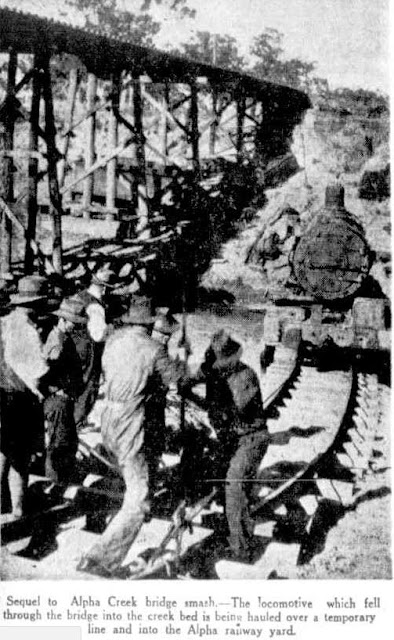 |
| A train accident in central Queensland has a happy ending. Published in the Central Queensland Herald, 14 August 1941 (John Oxley Library). |
British Government: While Winston Churchill is returning to Britain from Newfoundland aboard battleship HMS Prince of Wales, Clement Attlee makes sure that the terms of the Atlantic Charter (which is not yet called that, it is still referred to as the "Joint Declaration by the President and the Prime Minister"). Due to the fact that there is no "final document" of the charter, but is instead is a partially handwritten, partially verbal agreement, there is a slight difference between the US "version" that is broadcast over US radio and the British "version" that is broadcast over the BBC. This difference is quickly corrected. The Charter does not include any war objectives, just post-war plans.
Incidentally, most histories record 14 August 1941 as the date of the Atlantic Conference that results in the Atlantic Charter. However, in fact, the conference already is over by 14 August and both President Roosevelt and Prime Minister Churchill are heading back to their respective capitals. The joint communique is issued today, so this is when it comes to the public's attention, but the actual agreement is finalized on 13 August 1941.
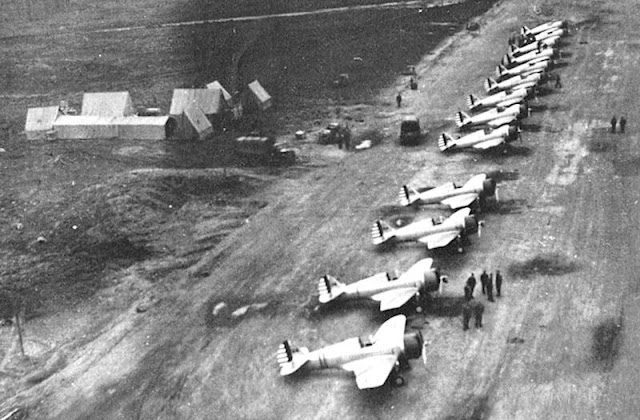 |
| P-36 Hawks of the 18th Pursuit Squadron lined up at Elmendorf Field, Alaska, August 1941 (US Air Force, USGOV-PD). |
After watching the F2A Buffaloes and SOC Seagulls of Scouting Squadron 201 (VS-201), Roosevelt continues down to Blue Hill Bay, Maine, where he re-embarks presidential yacht USS Potomac (AG-25).
German Government: Over lunch, Hitler expounds on the subject of ... top hats. It turns out that he has very definite views on top hats, and they are not favorable. He views them as a sign of the control of the plutocracy over the worker:
I sometimes entertain myselfby rummaging through old back-numbers of the [weekly newsreels]. I have a collection of them. It's truly instructive to plunge one's nose in them. At the launching of a ship, nothing but top-hats, even after the revolution! The people were invited to such festivities only as stage extras. The Kaiser received a delegation of workers just once. He gave them a fine scolding, threatening simply to withdraw the Imperial favour from them!These ramblings are illuminating on several scores. For one, they show one of the hidden sources of Hitler's appeal to the "masses" (as he likes to call them), and that is his dislike of the high-hat approaches (to borrow an apt phrase) of the past. In addition, he also critiques the German government's management of World War I, and not long after the Kaiser's passing in the Netherlands. This seems somewhat contrary to his constant public assertions of the "stab in the back" theory. Finally, while Hiler is deliberately gathering the operational reins of military command with both hands to the consternation of his generals, he is sitting around blithely talking about abstractions that reflect his true orientation and training - the political, and not the military.
China: The sustained Japanese bombing campaign against Chungking continues. The pilots seem to taunt the Americans in the embassy and the nearby gunboat USS Tutuila (PR-4), flying directly over them before dropping their loads elsewhere.
 |
| Saint Maximilian Maria Kolbe. |
Residents of the Jewish community of Lesko, Poland, are transported to Zaslaw, Poland, and executed.
Lionello Alatri, the spokesman for the Union of Italian Jewish Communities, writes to Vatican Secretary of State Cardinal Luigi Maglione to beg the pope's help for Croatian Jews. The letter describes brutalities against Jews in Zagreb and other Croatian cities. Maglione does not respond.
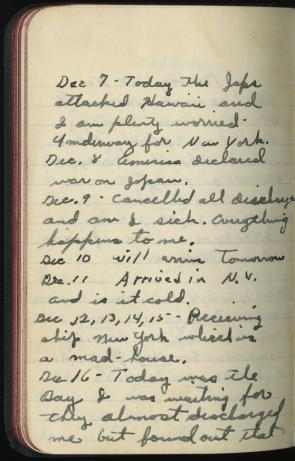 |
| The December 7, 1941 entry in Thomas Askins' diary - "I am plenty worried." (Gilder Lehrman Institute of American History). |
Future History: David Van Cortlandt Crosby is born in Los Angeles, California. He has difficulty in school and eventually drops out of Santa Barbara City College to pursue a musical career. After a brief stop in Chicago, he winds up in Greenwich Village, New York. He records his first solo session in 1963, then returns to Chicago, where he meets Jim McGuinn (later Roger McGuinn) and the two begin a band. Eventually, after adding more members, they form The Byrds, one of the top musical acts of the decade. Eventually, David Crosby leaves the band and hooks up with Stephen Stills. After Graham Nash joins them, they form Crosby, Stills & Nash, then, with the addition of Neil Young in 1969, Crosby, Stills, Nash & Young. After that, David Crosby pursues a solo career, sometimes working with his earlier bandmates and others. David Crosby also has done some acting and generally become a top US celebrity. He remains active as of this writing in 2018.
Constance June Smith is born in Elkhart, Indiana. She grows up to become one of the most respected singers in US country music. Over the course of her career, Connie Smith earns 11 Grammy award nominations, 20 top-ten Billboard country singles, and three no. 1 Billboard country albums. She is elected to the Country Music Hall of Fame in 2012. She remains active as of 2018, though apparently semi-retired.
August 1941
August 1, 1941: More Executions on Crete
August 2, 1941: Uman Encirclement Closes
August 3, 1941: Bishop von Galen Denounces Euthanasia
August 4, 1941: Hitler at the Front
August 5, 1941: Soviets Surrender at Smolensk
August 6, 1941: U-Boats in the Arctic
August 7, 1941: Soviets Bomb Berlin
August 8, 1941: Uman Pocket Captured
August 9, 1941: Atlantic Conference at Placentia Bay
August 10, 1941: Soviet Bombers Mauled Over Berlin
August 11, 1941: Rita Hayworth in Life
August 12, 1941: Atlantic Charter Announced
August 13, 1941: The Soybean Car
August 14, 1941: The Anders Army Formed
August 15, 1941: Himmler at Minsk
August 16, 1941: Stalin's Order No. 270
August 17, 1941: Germans in Novgorod
August 18, 1941: Lili Marleen
August 19, 1941: Convoy OG-71 Destruction
August 20, 1941: Siege of Leningrad Begins
August 21, 1941: Stalin Enraged
August 22, 1941: Germans Take Cherkassy
August 23, 1941: Go to Kiev
August 24, 1941: Finns Surround Viipuri
August 25, 1941: Iran Invaded
August 26, 1941: The Bridge Over the Desna
August 27, 1941: Soviets Evacuate Tallinn
August 28, 1941: Evacuating Soviets Savaged
August 29, 1941: Finns take Viipuri
August 30, 1941: Operation Acid
August 31, 1941: Mannerheim Says No
2020



